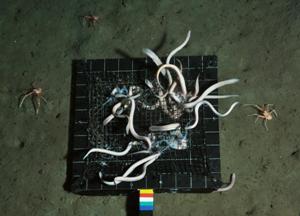Oct 16 2014
This week, researchers from University of Hawai'i, Norway, and the UK have shown with innovative experiments that a rise in jellyfish blooms near the ocean's surface may lead to jellyfish falls that are rapidly consumed by voracious deep-sea scavengers. Previous anecdotal studies suggested that deep-sea animals might avoid dead jellyfish, causing dead jellyfish from blooms to accumulate and undergo slow degradation by microbes, depleting oxygen at the seafloor and depriving fish and invertebrate scavengers, including commercially exploited species, of food.
 This image depicts hagfish and crustacean amphipods scavenging jellyfish baits in the deep sea. Credit: Credit: A. Sweetman, C. Smith, D. Jones
This image depicts hagfish and crustacean amphipods scavenging jellyfish baits in the deep sea. Credit: Credit: A. Sweetman, C. Smith, D. Jones
Globally there are huge numbers of jellyfish in the oceans. In some parts of the ocean, jellyfish "blooms" are increasing apparently due to nutrient enrichment and climate change caused by human activities. In recent years, studies have suggested that when jellyfish blooms die-off, massive quantities of jellyfish sink out of surface waters and can deposit as "jelly-lakes" at the seafloor, choking seafloor habitats of oxygen and reducing biodiversity. This latest research shows that the accumulation of dead jellyfish lakes may be unusual, with jellyfish carcasses normally being rapidly consumed by a host of typical deep-sea scavengers such as hagfish and crabs.
"We just had a hunch that dead jellyfish were important to deep-sea ecosystems in some way, even though they are made up largely of water. We therefore decided to film what the fate of jellyfish carcasses were at the seafloor so we deployed deep-sea lander systems with jellyfish bait. When we later retrieved the landers and found no jellyfish attached to the bait plates we were pleasantly surprised. However, our surprise jumped to another level when we looked at the camera images and saw just how fast the jellyfish baits were consumed and the shear number of scavengers that were consuming the baits. It just blew our minds." lead author Andrew K. Sweetman said. Sweetman is a chief senior scientist and research coordinator for deep-sea ecosystem research at the International Research Institute of Stavanger in Norway.
Published October 15 in the prestigious journal Proceedings of the Royal Society: Biological Sciences, the research looked at the response by scavengers to jellyfish and fish baits in the deep-sea along the Norwegian margin. The researchers found that jellyfish and fish baits were consumed equally fast and attracted similar densities of a diversity of scavengers.
"The speed of the jellyfish scavenging was totally unexpected because earlier, previous observations seemed to suggest that jellyfish carcasses would just rot very slowly at the seafloor. It was also really interesting that the hagfish targeted the most energy-rich parts of the jellyfish, burrowing into the jellyfish carcasses to eat the gonads!" said Craig R. Smith, co-author, designer of the deep-see camera-lander systems used in the study, and a Professor of Oceanography and Pew Fellow in Marine Conservation at the University of Hawai'i at Mānoa, USA.
The study further revealed that the role of jellyfish material could be seriously underestimated in global carbon budgets in the ocean, because jellyfish were removed so quickly that they fail to accumulate at the seafloor, causing scientist to overlook their role in deep-sea food webs.
"Our work shows that previous assessments of the ocean carbon cycle may have missed an important component. Until we saw these photos we thought that the massive amount of jellyfish material was deposited on the seafloor and was essentially taken out of the system – removing carbon rapidly. Our results show that much of this carbon could, in fact, make it into deep-sea food webs, fueling these systems. This is especially important when other food sources to deep-sea ecosystems may be decreasing as our oceans warm" said co-author Daniel Jones, a scientist at the National Oceanography Center in Southampton UK.
Ultimately, this new research reveals that jellyfish blooms could provide far-reaching, potentially important, food supplements to normal deep-sea food webs, rather than having purely negative impacts on fisheries and marine ecosystem function.